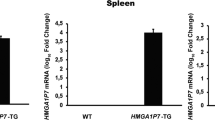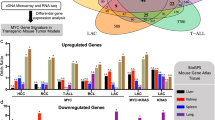Abstract
We have previously identified the oncogene rgr (ralGDS related) in DNA derived from a rabbit squamous cell carcinoma. Here we describe the identification of the human orthologue of the rabbit rgr gene termed hrgr (human ralGDS related). Four alternatively spliced full-length hrgr transcripts were isolated from normal human testes and liver libraries. Truncation of hrgr confers transforming ability to its cDNA. Using a RT–PCR assay we have been able to detect the expression of an abnormally truncated transcript in several human T-cell lymphoma lines, and in fresh tissue samples of patients with T-cell malignancies. In the DHL cell line, an Anaplastic Large Cell Lymphoma (ALCL) line, a DNA rearrangement was detected within the hrgr gene region. We propose that these T-cell lymphomas, at least in part, owe their malignant phenotypes to genetic alterations of the hrgr gene. These findings also raise the possibility that mutations in the hrgr gene are involved in other malignancies.
This is a preview of subscription content, access via your institution
Access options
Subscribe to this journal
Receive 50 print issues and online access
$259.00 per year
only $5.18 per issue
Buy this article
- Purchase on Springer Link
- Instant access to full article PDF
Prices may be subject to local taxes which are calculated during checkout






Similar content being viewed by others
References
Albright CF, Giddings BW, Liu J, Vito M, Weinberg RA . 1993 EMBO J. 12: 339–347
Ausubel FM, Brent R, Kingston RE, Moore DD, Smith JA, Seidman JG, Struhl H . 1987 Current Protocols in Molecular Biology New York, USA: John Wiley and Sons, Inc 4.9.1–4.9.9
Bouck N, Di Mayorca G . 1979 Methods Enzymol. 58: 296–302
Chissoe SL, Bodenteich A, Wang YF, Wang YP, Burian D, Clifton SW, Crabtree J, Freeman A, Iyer K, Jian L, Ma Y, McLaury H-J, Pan H-Q, Sarhan OH, Toth S, Wang Z, Zhang G, Heisterkamp N, Groffen J, Roe BA . 1995 Genomics 27: 67–82
D'Adamo DR, Novick S, Kahn JM, Leonardi P, Pellicer A . 1997 Oncogene 14: 1295–1305
Hernandez-Muñoz I, Malumbres M, Leonardi P, Pellicer A . 2000 Oncogene 19: 2745–2757
Jiang XY, Trujillo JM, Liang JC . 1990 Blood 76: 597–601
Leon J, Kamino H, Steinberg JJ, Pellicer A . 1988 Mol. Cell. Biol. 8: 786–793
Pellicer A, Robins D, Wold B, Sweet R, Jackson J, Lowy I, Roberts JM, Sim GK, Silverstein S, Axel R . 1980 Science 209: 1414–1422
White MA, Vale T, Camonis JH, Schaefer E, Wigler MH . 1996 J. Biol. Chem. 271: 16439–16442
Acknowledgements
We would like to acknowledge the technical help of Hamid Saadati, the assistance of Roberto Piva and the helpful discussions with Robert Schneider, Jorge Ghiso and Dan Jacobson. This work has been supported by a grant from NIH, CA50434.
Author information
Authors and Affiliations
Corresponding author
Rights and permissions
About this article
Cite this article
Leonardi, P., Kassin, E., Hernandez-Muñoz, I. et al. Human rgr: transforming activity and alteration in T-cell malignancies. Oncogene 21, 5108–5116 (2002). https://doi.org/10.1038/sj.onc.1205694
Received:
Revised:
Accepted:
Published:
Issue Date:
DOI: https://doi.org/10.1038/sj.onc.1205694
Keywords
This article is cited by
-
Demographic and genetic factors influence the abundance of infiltrating immune cells in human tissues
Nature Communications (2020)
-
RalA is overactivated in medulloblastoma
Journal of Neuro-Oncology (2016)
-
The human Rgr oncogene is overexpressed in T-cell malignancies and induces transformation by acting as a GEF for Ras and Ral
Oncogene (2011)
-
Ral GTPases and cancer: linchpin support of the tumorigenic platform
Nature Reviews Cancer (2008)
-
Comprehensive genetic and epigenetic analysis of sporadic meningioma for macro-mutations on 22q and micro-mutations within the NF2 locus
BMC Genomics (2007)



